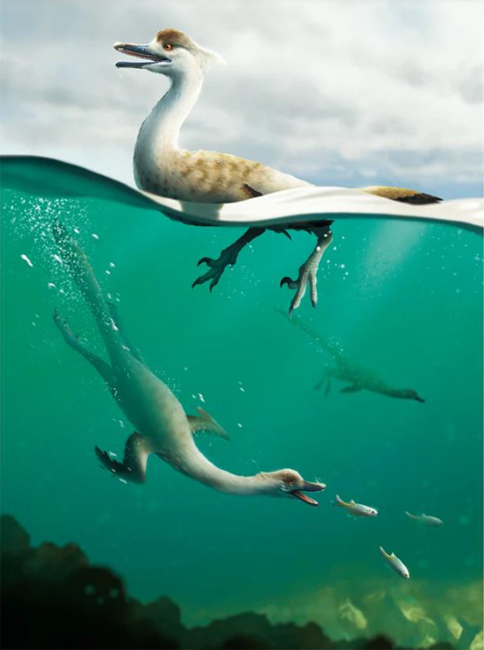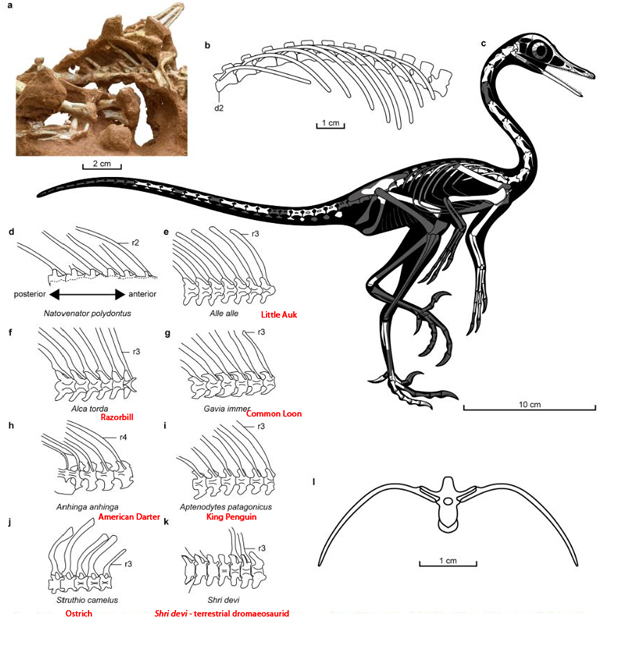New Research Suggests Natovenator was a Semi-aquatic Dinosaur
Scientists have concluded that a newly described dromaeosaurid from Mongolia with its streamlined body may have been semi-aquatic. The duck-sized theropod, named Natovenator polydontus had a ribcage that angled downwards towards the pelvis, an anatomical trait also found in extant diving birds. The researchers, writing in the journal “Communications Biology”, suggest that this dinosaur, a relative of Velociraptor, could potentially have been a swimming predator, hunting and catching fish.

Natovenator polydontus
The semi-articulated fossil specimen was discovered in 2008 by a joint Mongolian/Korean field team. The material consisting of substantial postcranial elements and a partial skull comes from the Barun Goyot Formation at Hermiin Tsav in the southern Mongolian Gobi Desert. Phylogenetic analysis suggests that Natovenator polydontus is closely related to Halszkaraptor (H. escuilliei) which heralds from southern Mongolia too, but from slightly older strata – the Djadochta Formation.
When Halszkaraptor was formally described in 2017, it was proposed that this dromaeosaurid was adapted to a life in water. The discovery of Natovenator adds weight to the theory that some dromaeosaurs were semi-aquatic. The two dinosaurs, which were most probably feathered have been placed in the same clade – the Halszkaraptorinae.
To read Everything Dinosaur’s blog post about Halszkaraptor: The Remarkable and Diverse Maniraptora.
Natovenator A Semi-aquatic Dinosaur?
The dinosaur had a long, flexible neck and analysis of the jaws indicate that Natovenator had lots of small teeth, ideal for grabbing slippery fish.

The picture above shows the dorsal vertebrae and ribs of Natovenator in ventral view (a), with (b) a line drawing in left lateral view showing how the ribs are angled downwards towards the rear of the animal. Diving birds and penguins share this anatomical trait (e-i), which is believed to help these animals to be more streamlined when they dive and swim. Line drawing (j) shows the ribs of the entirely terrestrial ostrich whilst (k) shows the dorsal vertebrae and known ribs of Shri devi, another dromaeosaurid from the Barun Goyot Formation which was probably entirely terrestrial too.
Could the shape, direction and orientation of the ribs be evidence to suggest that Natovenator was semi-aquatic?
Swimming Hunter with Many Teeth
The dinosaur’s genus name translates from the Latin and means “swimming hunter”, whilst the specific or trivial name refers to the unusually large number of teeth located in the jaw. The anatomical position and orientation of the ribs has not been recorded in a non-avian dinosaur before. If Natovenator and the closely related Halszkaraptor were semi-aquatic, then this demonstrates the great diversity within the Theropoda. Dinosaurs evolving to exploit specific niches in ancient ecosystems.
A spokesperson from Everything Dinosaur commented that this was a remarkable discovery that once again highlighted the range of body plans that dinosaurs evolved to exploit niches within ecosystems. As many semi-aquatic animals today have dense bones, perhaps a study of the bone density of Natovenator might help confirm that this dinosaur was indeed, at home on the water.
Dromaeosaur Diversity
The Dromaeosauridae were a very successful group of theropod dinosaurs. Numerous genera have been described. To gain an appreciation of different dromaeosaurs, take a look at the extensive Beasts of the Mesozoic range of articulated “raptor” figures: Beasts of the Mesozoic Articulated Dinosaur Models.
The scientific paper: “A non-avian dinosaur with a streamlined body exhibits potential adaptations for swimming” by Sungjin Lee, Yuong-Nam Lee, Philip J. Currie, Robin Sissons, Jin-Young Park, Su-Hwan Kim, Rinchen Barsbold and Khishigjav Tsogtbaatar published in Communications Biology.

